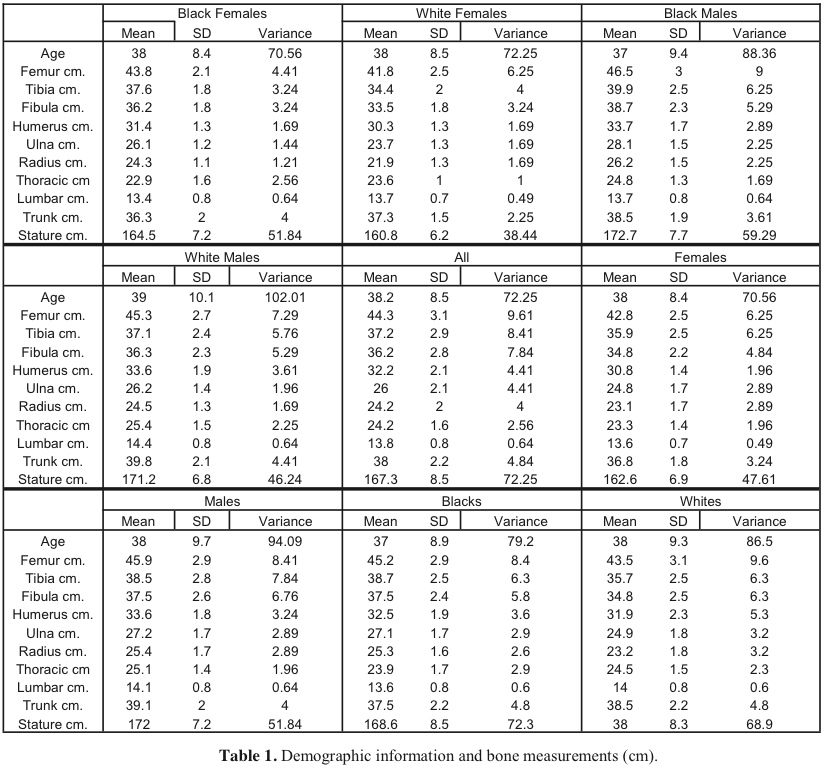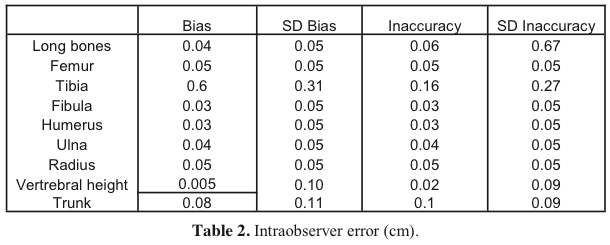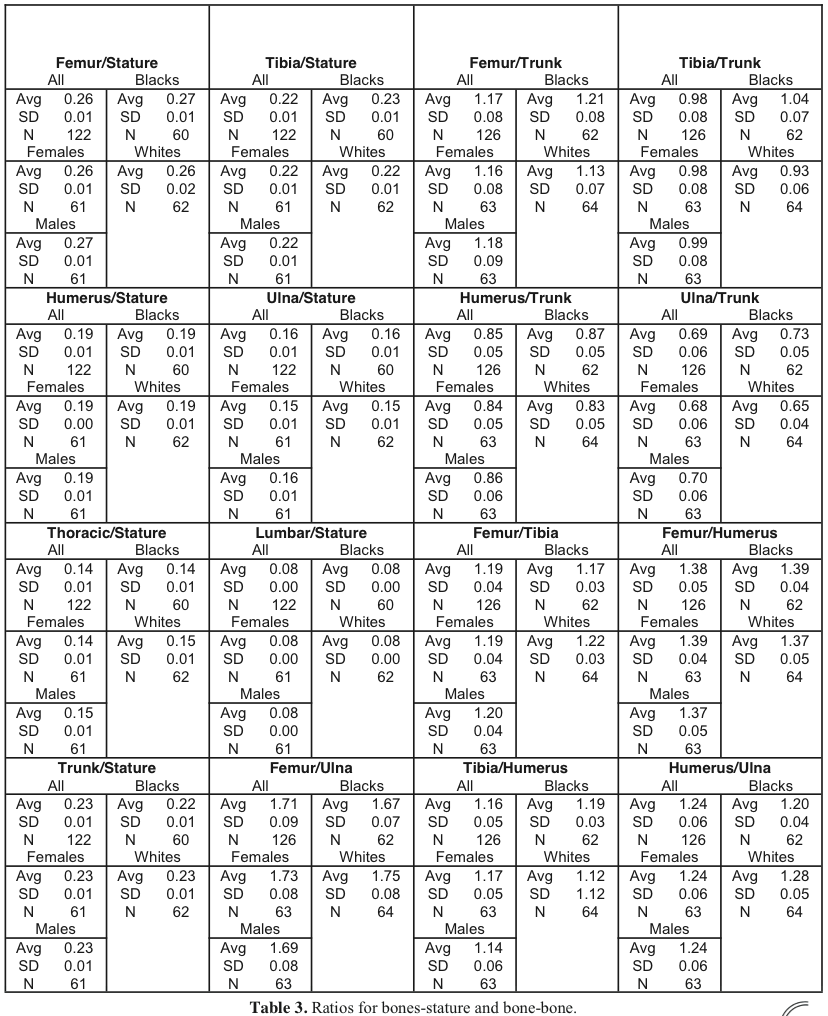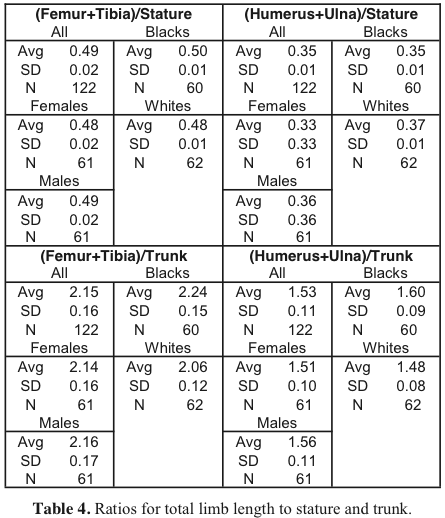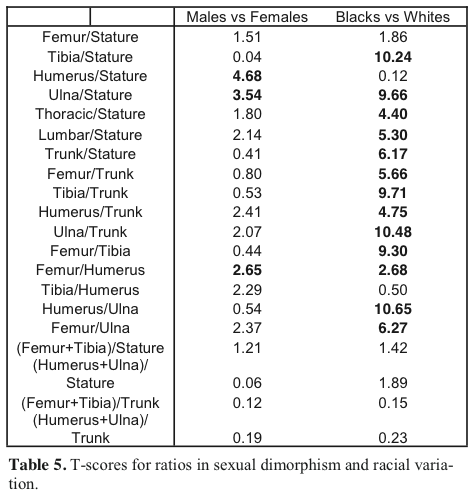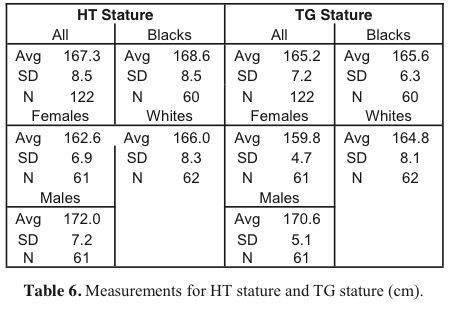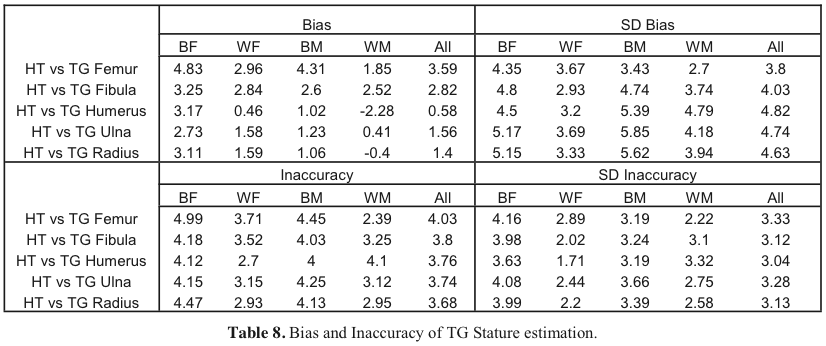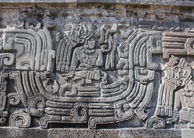From Discussions VOL. 5 NO. 1Covariation in Limb-limb and Limb-trunk Proportions in Whites and Blacks and Males in Females using the Hamann-Todd Collection, Cleveland Museum of Natural HistoryDISCUSSIONMost of the significant differences in limb and trunk between groups are based on racial affiliation rather than sexual dimorphism. Males have significantly longer arms (both proximal and distal) relative to stature than females. Females have shorter upper arms relative to thighs than males. There is no significant difference between Blacks and Whites in terms of femur relative to stature. Blacks have longer upper arms and shins relative to stature than Whites. Blacks also have longer thighs relative to upper arms than Whites. Whites have longer trunks relative to stature compared to Blacks in both the thoracic region and the lumbar region. Whites also have longer proximal limb segments relative to distal limb segments than Blacks. These ̳racial' differences were to be expected as they coincide with Bergmann's (1847) and Allen's (1877) rules. Bergmann's Rule states that within a single species, smaller-bodied organisms will be in the warmer climates and larger-bodied organisms will be in the colder climates. Allen's rule is similar, but adds that organisms with longer extremities (limbs) will be found in warmer climates and organisms with shorter extremities will be found in colder climates. Taken together, people with a smaller surface area, or SA, (Allen's rule) to body mass, or BM, (Bergmann's rule) ratio will be in colder climates and people with a larger SA/BM ratio will be in warmer climates (Ruff, 1994). The evolutionary adaptation behind this phenomenon is to increase heat retention in colder climates and increased heat loss (TaylorWeale and Vinicius, 2007). Paleooanthropological research has shown that humans have adapted to colder climates in Europe within the Upper Paleolithic. In the beginning, Europeans had longer limbs relative to stature than in modern-day European populations (Ruff, 2002). In the Hamann-Todd collection, my sample is consistent with this phenomenon; American Blacks retain the body proportions for a warmer climate and American Whites retain the body proportions for a colder climate. The Whites have longer trunks and shorter limbs relative to stature, and shorter arms relative to trunks than the Blacks. Blacks also have longer distal limb segments relative to trunk length. There is no significant difference in the ratios between total limb length (upper and lower) and stature, or trunk length, in either males and females, or among Blacks and Whites. The significant difference lies in the distal limb segments, which are longer in Blacks than Whites. There is a significant correlation between all of the long bones and stature within each subgroup and within the entire sample as a whole. Overall, the femur is the best predictor of stature. This is to be expected since the T-test indicated that there was no significant difference in the femur-stature ratio between either Blacks and Whites, or males and females. Thus, the femur tends to have a stable relationship with stature across sex and population boundaries. In females, the best predictor of stature is the humerus. The humerus is not the worst predictor of stature in males, but it is worse in males than in females. The T-test indicated that there was not a significant difference in the ratio of humerus-stature on the basis of race, but there is a significant difference on the basis of sex. Women have shorter humeri than men, but the humerus has a more stable relationship to stature in females than in males. In Black females, both the femur and the humerus, taken independently, are the best predictors of stature. In White females, the tibia is the best predictor. In Black and White males, the femur is the best predictor. In Blacks, the femur, tibia, and humerus all equally predict stature the best. In Whites, the femur alone is the best. The lumbar region is significantly correlated to stature in each group, except for Black males, which suggests that Black males have higher variability in the length of the lumbar region. The thoracic region is significantly correlated in Blacks and Whites, the sample as a whole, and among White males. White males have the least amount of variability in the thoracic region, and there is a significant correlation with ancestral populations as opposed to sexual dimorphism. When determining the best Trotter and Gleser (1952) equation to estimate stature, different statistical analyses yield different results. ̳Best' can be defined as the highest r value in least squares regression, and the value closest to zero in the calculation of bias. The least squares regression analysis indicates that the equation using the humerus is the best estimate in Black females, the fibula in White females, and the femur in both Black and White males. However, when deciding based upon the value for bias, the ulna is the best for Black females, the humerus is the best for White female and Black males, and the radius is the best for White males. The similarities between the correlation values and preferred equation indicate that for the specified bone, the sample that Trotter and Gleser measured represents the sample that I measured in the hierarchy of correlation. However, the T-test indicates that there is significant difference between the true stature and estimated stature in for all subgroups except Whites and males. The formulae provided by Trotter and Gleser underestimate stature for every bone in each subgroup, except for the humerus and radius in White males. For the average of every equation used, Trotter and Gleser underestimate stature in every sub-group; the least amount in White males and the most in Black females. Thus, it can be inferred that the original sample used by Trotter and Gleser is most similar to the Hamann-Todd sample I measured in White males, and least similar in Black females. There are several limitations to the results of this study. First, the accuracy of stature measured by Todd may be invalid because the measurements were conducted on cadavers and not living individuals. Although Dupertuis and Hadden (1951) consider the measurement of cadavers to be equivalent to living stature, there is no way of knowing the stature in life of the persons in the Hamann-Todd collection to compare the two. Stature is a dynamic trait that varies throughout the day and throughout life. At the end of puberty, long bones have a constant relationship to each other. The length of the vertebral column decreases with age due to gravity putting force on the intervertebral disks as well as arthritis decreasing the angle between adjacent vertebrae. The end result is that the back hunches and stature is shorter. Therefore, to qualify stature as one measurement may not validly describe overall stature. Although I tried to minimize this effect as best as possible, it is unknown whether or not it was completely controlled for in the study. Second, there is questionable reliability and validity in the assessment of race. Racial classification was assigned based upon observations of colloquial traits on dead bodies; that is to say that different observers may disagree on the racial assignment of a particular individual. Even if every American were to agree upon the racial classification of a specimen, there still remains the fact that the ancestry is not known and any conclusions based on population variation would be skewed. Many American Blacks have mixed ancestry, even though they consider themselves to be exclusively Black. The Whites included in this study come from a mixed European ancestry. The definition of White or Black depends upon the decision of Todd in the early 1900's. This is the problem with any study in regional variation, and its limitations have an effect on this study. Thirdly, this study excludes ̳abnormal' amounts of vertebrae. Many people have extra vertebra or may be missing a certain number. The present study considers only those who have twelve thoracic vertebrae and 5 lumbar. The results may be different if individuals with ̳abnormal' amounts were included. Lastly, the individuals in this study lived in the early 1900's and much secular change may have taken effect between then and now. Therefore, this study may not be applicable to a modern-day population or to a population outside of Cleveland, Ohio. AcknowledgementsI would like to thank Dr. Scott Simpson from the department of Anatomy for advising me in this research as well as Lyman Jellema for allowing me to use the Hamman-Todd Osteological collection at the Cleveland Museum of Natural History. ReferencesAllen JA (1877) The influence of physical conditions on the genesis of species. Radic Rev. 1:108-140. Angel A, Cisneros HB (2004) Technical Note: Modification of regression used to estimate stature in Mesoamerican skeletal remains. Am. J. Phys. Anthrop. 125:264-265 Asala SA, Bidmos MA, Dayal MR, Discriminant function sexing of fragmentary femur of South African Blacks. For. Sci Intl 145:25 -29. Bergmann C (1847) Uber die Verhaltniesse der Warmeokonomie der Thiere zu Ihrer Grosse. Gottingen Stud 4:529-539. Celbis O, Agritmis H (2006) Estimation of stature and determination of sex from radial and ulna bone lengths in a Turkish corpse sample. For. Sci. Intl.158:135-139. Chibba K, Bidmos MA (2007) Using tibia fragments from South Africans of European descent to estimate maximum tibia length and stature. For. Sci. Intl.169:145-151. Dupertuis CW, Hadden JA (1951) On the reconstruction of stature from long bones. Am. J. Phys. Anthrop. 9:15-53. Duyar I, Pelin C (2003) Body height estimation based on tibia length in different stature groups. Am. J. Phys. Anthrop. 122:23-27 El-Meligy M et al. (2006) Estimation of human body built in Egyptians. For. Sci Intl 159:27-31 Giannecchini M, Moggi-Cecchi (2008) Stature in archaeological samples from central Italy: methodological issues and diachronic changes. Am. J. Phys. Anthrop. 135:284-292 Gorden-Larsen P, Zemel BS, Johnston FE (1997) Secular changes in statue, weight, fatness, overweight, and obesity in urban African-American Adolescents from the mid-1950's to the mid-1990's. Am J Hum Biol 9:675-688. Hauser R, Smolinsky J, Gos T (2005) The estimation of stature on the basis of measurements of the femur. For. Sci Intl 147:185-190. Holden C, Mace R (1999) Sexual dimorphism in stature and women's work: a phylogenetic cross-cultural analysis. Am. J. Phys. Anthrop. 110:27-45. Holliday TW, Ruff CB (2001) Relative variation in human proximal and distal limb segment lengths. Am. J. Phys. Anthrop. 116:2633. Holland TD (1992) Estimation of adult stature from fragmentary tibias. J For. Sci. 37:1223-1229. Iscan Y, Shihai D (1995) Sexual dimorphism of the Chinese femur. For. Sci. Intl. 74:79-87. Jantz RL (1992) Modification of the Trotter and Gleser female stature estimation formulae. Journal of Forensic Sciences 37:12301235. Katzmaryzk PT, Malina RM (1999) Body size and physique among Canadian of First Nation and European ancestry. Am. J. Phys. Anthrop. 108:161-172. Mall G et al. (2001) Sex determination and estimation of stature from the longbones of the arm. For. Sci. Intl. 117:23-30. Mendonca MC (2000) Estimation of height from the length of long bones in a Portuguese adult population. Am. J. Phys. Anthrop. 112:39-48. Petrovecki V et al. (2007) Prediction of stature based on radiographic measurements o cadaver long bones: a study of the Croatian population. J. of For. Sci. 52:547-552. Pretty GL, Henneberg M, Lambert KM, Prokopec M (1998) Trends in stature in South Australian Aboriginal Murraylands. Am. J. Phys. Anthrop. 106:505-514 Radionova D, Tenekedjiev K, Yordanov Y (2002) Stature estimation from long bone lengths in Bulgarians. HOMO 52:221-232. Raxter MH, Auerbach BM, Ruff C (2006) Revision of the Fully Technique for Estimating Statures. Am. J. Phys. Anthrop. 130:374384. Raxter et al. (2008) Stature estimation in ancient Egyptians: a new technique based on anatomical reconstruction of stature. Am. J Phys. Anthropol. 136:147-155. Ruff C (1994) Morphological adaptation to climate in modern and fossil hominids. Yrbk Phys. Anthropol. 37:65-107. Ruff C (2002) Variation in human body size and shape. Annu. Rev. Anthropol. 31:211-32. Silventoinen K (2003) Determination of variation in adult body height. J. Biosoc. Sci. 35:263-285. Simmons T, Jantz MA, Bass WM (1990) Stature estimation from fragmentary femora: a revision of the Steele method. J. For. Sci. 35:628-636. Steele DG, McKern TW (1969) A method for assessment off maximum long bone length and living stature from fragmentary long bones. Am. J. Phys. Anthrop. 31:215-228. Steyn M, Smith JR (2007) Interpretation of ante-mortem stature estimates in South Africans. For. Sci. Intl. 171:97-102. Stunkard AJ, Foch TT, Hrubec Z (1986) A twin study of human obesity. J. Am. Med. Ass. 256:51-54. Taylor-Weale R, Vinicius L (2007) Independent roles of climate and life history in hunter-gatherer anthropometric variation. Int. J. Biol. Anthrop. 1:9-9. Trotter M, Gleser GC (1952) Estimation of stature from Long Bones of American Whites and Negroes. Am. J. Phys. Anthropol. 10:463-514. White T (2000) Human Osteology. San Diego, CA: Academic Press. Zakrzewski SR (2003) Variation in ancient Egyptian stature and body proportions. Am. J Phys. Anthropol. 121:219-229. Endnotes
Tables
Suggested Reading from Inquiries Journal
Inquiries Journal provides undergraduate and graduate students around the world a platform for the wide dissemination of academic work over a range of core disciplines. Representing the work of students from hundreds of institutions around the globe, Inquiries Journal's large database of academic articles is completely free. Learn more | Blog | Submit Latest in Anthropology |









